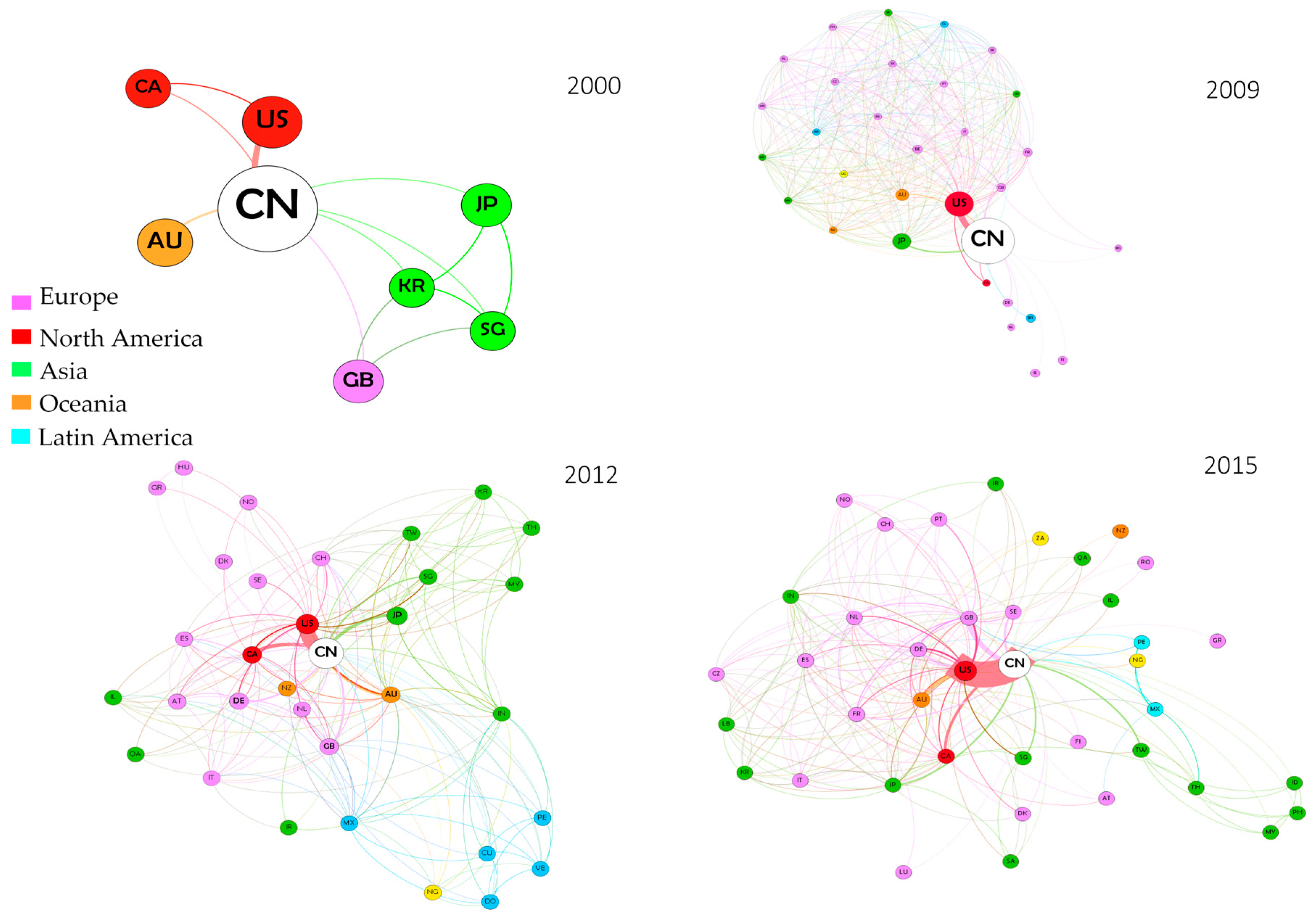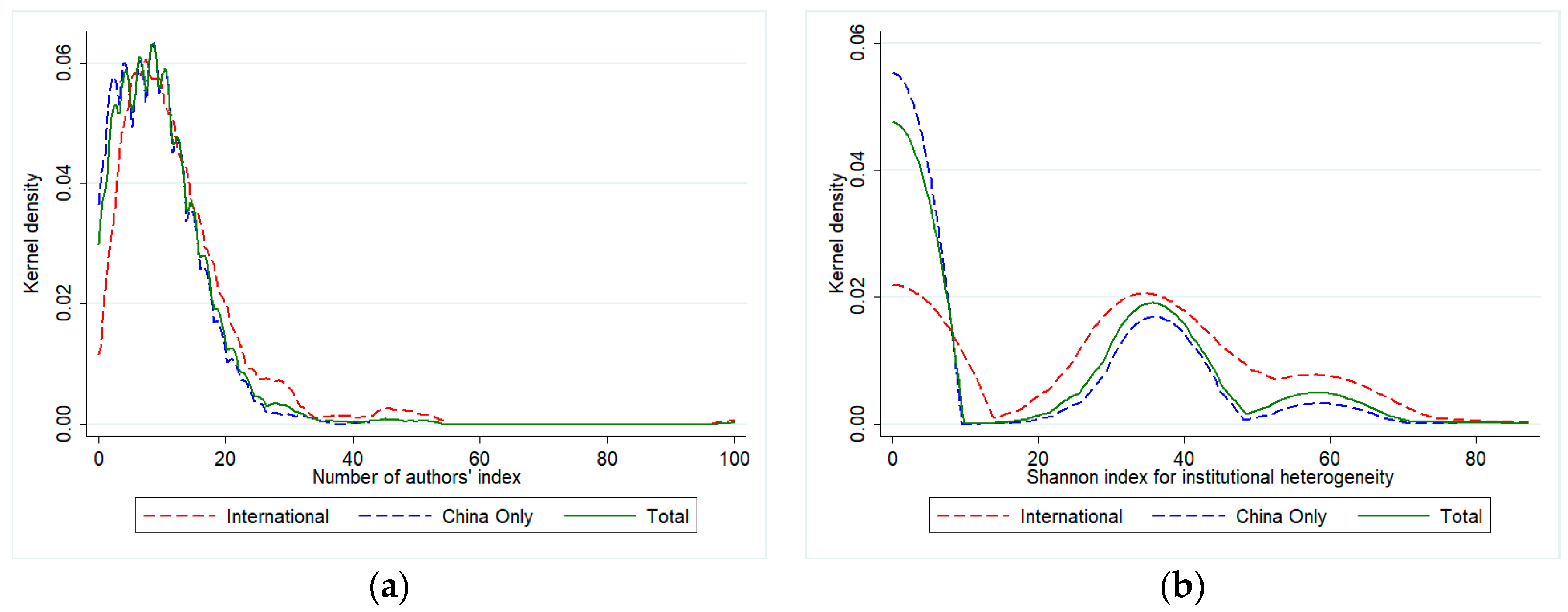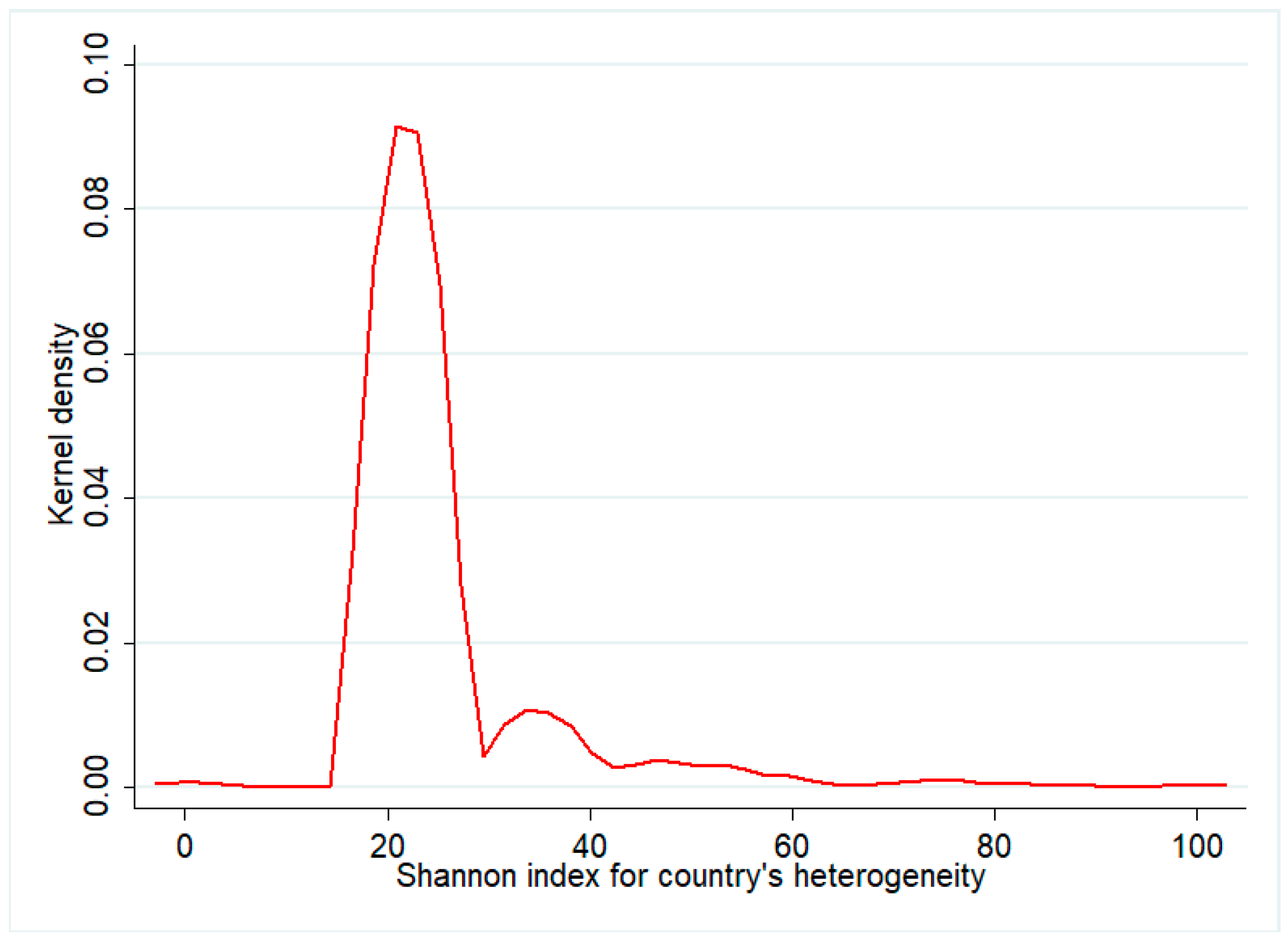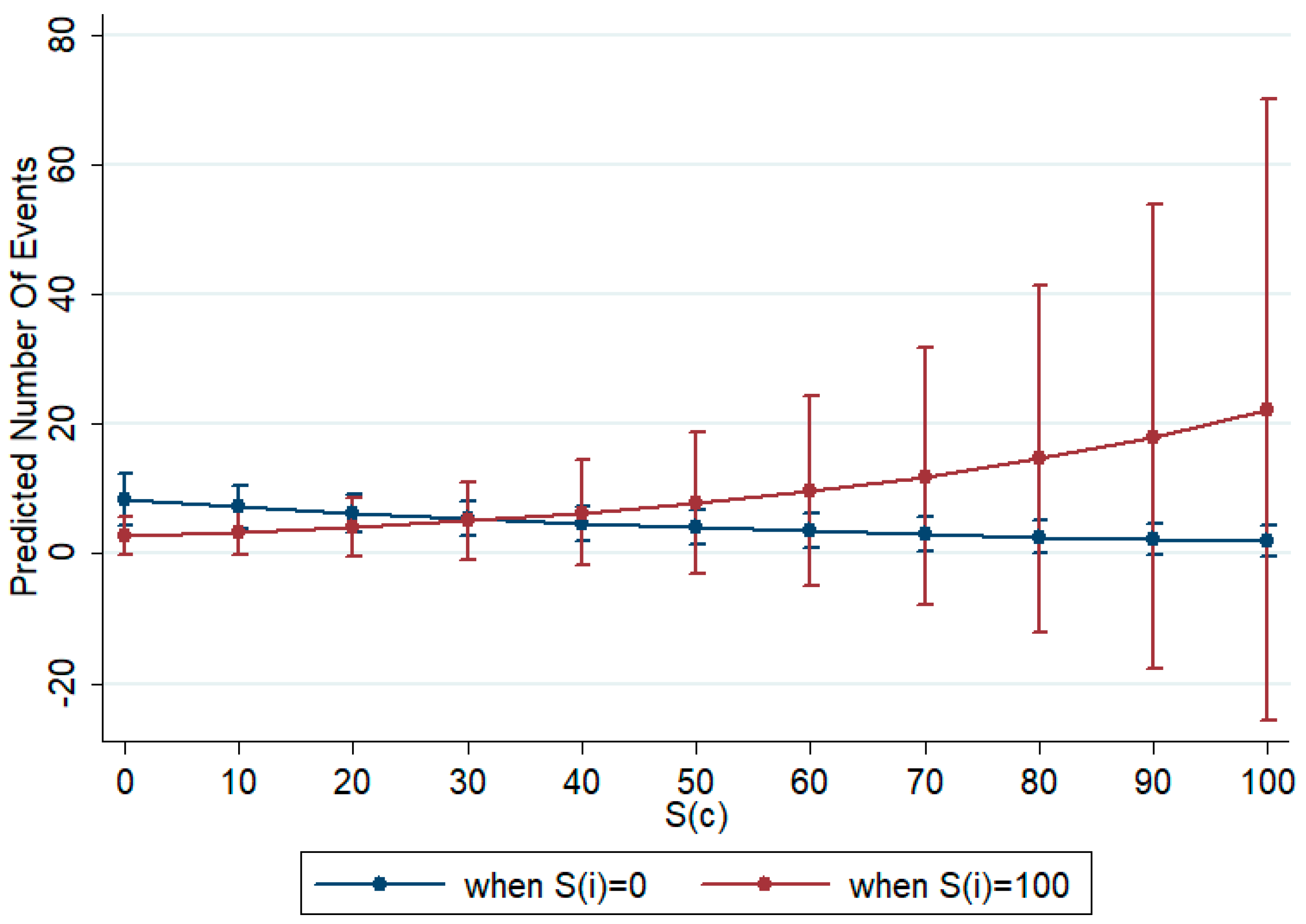1. Introduction
In the modern age, science is characterized by a generalized enlargement of research networks. The number of authors taking part in a single publication has increased. In particular for medical sciences, we observe that the average number of authors per article in PubMed has passed from 2.0 in 1970 to 5.3 in 2010 [
1]. The complexity in handling scientific cooperation networks has also been rising over the years, because cooperation increasingly takes place at transnational level [
2,
3,
4,
5,
6,
7]. In 2010 almost 25% of research articles included authors from at least two countries (against 10% in 1990) [
8]. Such process has been called the “globalisation of science” [
9]. Not only scientific cooperation networks have increasingly included several researchers from different countries. They have recently also seen the contribution of authors coming from different types of institutions, with different general goals and organization [
10].
Large, multi-national and multi-institutional collaboration networks are challenging since they embed high risks and wide opportunities.
As far as risks are concerned, the early theories of collective actions suggest that, typically, large groups have more problems in cooperating because of possible free-riding, costs of coordination, monitoring and sanctioning [
11]. These costs might increase for scientific cooperation involving distant disciplinary fields, even if it has also been said that this kind of interaction might be a fertile soil for the emergence of radically new ideas [
12]. Other costs (in terms of funds and time) might be due to the mobility of equipment and personnel, but also to the necessity of preparing, defining and managing the agreement or of coordinating all the actors involved. There might be difficulties in putting together different cultures, financial and reward systems, and so on [
13]. The smooth functioning of networks furthermore requires that the intention distance among actors in terms of goal is not too large [
14]. Indeed, intention distance and network complexity can mutually reinforce each other, as with the growth in the number and variety of actors participating in the network, it is more likely that goals diverge [
15]. In this framework, a university-to-university relation might be somewhat easier to manage than a relation involving firms, since partners operate in similar institutions and share the same set of values. With different institutional partners there might instead be different positions regarding the disclosure of the results, different priorities due to different career paths or different degrees of intensity in the effort put in the relationship [
16].
Transnational research networks (TRNs from now on) may incur in even higher difficulties when they involve other institutions. This is the case of TRN aimed at the production of health knowledge. In fact, this field involves public as well as private producers, collective entities as well as individuals, profit oriented as well as non-profit organisations (i.e., hospitals, laboratories, physicians, etc.). It is very likely, therefore, that each category has a different main goal (profit maximization, provision of the service per se, societal wellbeing etc.) that leads to a different interpretation of the role that every actor is supposed to have in the sector. Moreover, further sources of complexity are related to the nature of the knowledge produced in the health sector, which usually requires high-tech devices and techniques and the ability to handle them, as well as the capacity to meet high quality standards that require rigorous quality controls. Consequently, participants in knowledge co-production networks in this sector are required to have high and flexible technical knowhow and knowledge skills.
The complexity of networking in these contexts may translate into a higher degree of fragility of the relation. Networks might be destined to fail due to relevant information asymmetries, wide free-riding opportunities, and potential conflicts in defining rules, goals and strategies.
However, in present times complex transnational networking in co-production of knowledge—also and in particular in the health sector—is seen by many as highly desirable. Cooperation allows to have access to new expertise and complex equipment, due to the growing complexity of science; increases the efficiency and speed of the research work, thanks to the possibility of counting on a larger team; facilitates the study of more complex and multidisciplinary problems; allows a cross fertilization of competences that facilitates the birth of new ideas; gives scientists the possibility to directly learn new competences by interacting with others, reducing isolation; makes the research work more pleasant and stimulating, by giving to people the possibility to interact with others and to travel; and improves the accessibility to funds. The consequence is an increase in prestige and visibility of participants, who can multiply the possibility to get in touch with other colleagues, and to enhance their professional status. Studies show in fact that collaboration can result in a higher rate of acceptance for publication from prestigious journals, in a higher academic productivity (in terms, for example, of number of published papers) and in a higher quality of research [
4,
6,
13,
16,
17,
18,
19,
20,
21]. On the contrary, researchers working in isolation are less productive, less informed and consequently less acknowledged [
22]. Co-research ultimately contributes to the scientific progress, allowing to combine and integrate competences, to ignite cross-fertilization procedures and to favor the interchange of experiences [
23,
24].
In the broad scenario of transnational research cooperation, China is one of the most interesting cases. Starting from the launch of the open door policy, China has put it at the center of its scientific and technological development, as a key factor to favor the modernization of the country [
25,
26]. Consequently, its position within the international scientific scenario has been constantly increasing over the years [
27]. Furthermore, the national scientific community is increasingly open to international partnerships. Up to the eighties, the number of internationally co-authored papers of scientists located in China was very limited, since in the pre-reform period only a few selected scholars were allowed to publish in international journals, and they were strictly controlled. Afterwards, the government has constantly increased its commitment towards the improvement of international collaboration in science and technology, with the first boost given by the S&T Cooperation Program for Priority Projects launched with the 10th Five-Year Plan 2000–2005. Since then, all the Chinese research institutions, including universities, have increased the programs and incentives to international collaboration and there has been a constant increase in the number of internationally co-authored papers in the country [
28]. Such increase may be explained by the opportunity, given to Chinese researchers by international collaborations, to access advanced knowledge and instruments, and enter more visible circuits, therefore enhancing their potential impact [
29].
The habit of carrying out collaborative research within transnational research networks is much more common in health-related fields than in other scientific disciplines. Currently, around 50% of articles published by Chinese scientists in ISI-Web of Science journals on health issues were characterized by collaborations with foreign scientists, against a much lower 20% of the total Chinese publications.
In this framework, we believe it is particularly interesting to deepen our knowledge on the evolution over time of TRN involving Chinese scholars and on the factors affecting the quality of research carried out in health-related fields, with particular reference to the impact that complexity of TRN may have. To do so, the study focuses on the field of geriatrics and gerontology (hereinafter gerontology). This specific field has been chosen for several reasons:
- (1)
Given the current effects that 30 years of one-child policy are showing on the population aging, the field is increasingly popular among scientists (and policy makers), as ageing of Chinese population is becoming a growing concern [
30,
31,
32];
- (2)
Studying a very specific field allows to avoid comparisons among different sectors, that might have different behaviors in terms of co-publishing and citations [
33,
34,
35];
- (3)
The number of papers produced in the selected field, despite the growing popularity, is still small enough to allow to collect the detailed information that is needed to perform the study across time. At the same time, numbers are high enough to apply an econometric model sufficiently reliable.
3. Results and Discussion
Table 4 shows the results for the negative binomial regression of the three specifications of the model we identified previously, while
Table 5 reports the average marginal effects. Columns 1 in both tables report the results for the baseline model. Concerning our three dimensions of complexity, the
institutional heterogeneity does not affect quality, while
country’s heterogeneity is significant (and negative) only in the second formulation, when we introduce the interaction terms. However, such negative effect has a rather limited magnitude (−0.09 citations every increase of 1 point in the index). The only dimension of complexity that seems to affect—positively—the quality of publications in all three formulations is the standardized
number of authors. However, this is not sufficient to assert that larger co-authorship networks translate in better research. With a higher number of authors, in fact, the number of citations might increase simply because there are more possibilities for the article to be found and read. This is because each of the authors not only might have his/her own citation rings, but is also simply another possible keyword to be used to search for the article. More information on the role of this variable will be deduced by the use of interaction terms in the second formulation of the model.
As far as the other determinants of research quality are concerned, the three formulations provide the same results for some variables:
The degree of interdisciplinarity of the publication seems to negatively affect its quality. In fact, the number of sectors to which the publication refers has a negative impact on the number of citations;
The absence of a reprint author noticeably decreases the quality of publications, causing a reduction in the number of citations by 29.7 in comparison with articles with the indication of the reprint author. We have considered the corresponding author as the person in charge of maintaining the relation with the journal and with the remaining actors in the partnership, therefore acting as the one de facto managing the relation. Even if it is not clear why some publications do not mention any reprint author, the effect that the lack of a direction has on the research quality seems to be evidently negative;
The participation of US institutions in the partnership always has a positive impact on citations, which increase—due to this participation—by a range that goes from 2 to 2.5, depending on the specification, as shown in
Table 5. Other formulations of our model have been tested including other countries, such as those belonging to the G7 group, but no one has resulted to have an impact, apart from the USA. It is possible to read this result both as an effect of the possibility of accessing high tech research laboratories, world-renowned scientists and top scientific circuits, but also simply as a consequence of a higher visibility of US scientists and of a common habit of Americans to cite each other. Undoubtedly, at present the scientific world is US-centered, and our results confirm that being able to be part in this world allows to increase the visibility (and possibly the quality) of the carried out research.
To publish in journals with a high impact factor raises the number of received citations. This might occur because publishing a paper in a prestigious journal (i.e., highly ranked in terms of Impact Factor) per se increases the possibilities to receive a high number of citations. However, this should not be read as a weakness in the use of citation counts for the measurement of quality. On the contrary, considering that journals included in the impact factor system are all peer-reviewed, it seems to confirm the fact that a positive assessment from peers anticipates an equally positive assessment from the scientific audience.
The presence of universities in the partnership also increases citations. This aspect might be simply related to the fact that to cite previous works is particularly diffused within academic circuits. For analogous reasons also university-hospitals have a positive impact, but only in the first formulation.
As far as
interactions are concerned, the effect of the one between countries and institutional complexity indices is positive, while that between institutional heterogeneity and number of authors is negative. However, a correct interpretation of the meaning of the interactive terms requires some specifications. Because marginal effects of each variable are computed keeping all other variables fixed, a correct estimate of such effects should not include the values for interaction terms [
55]. This is because, by definition, the value of the interaction is dependent on the value assumed by its components, so its marginal effect on the outcome of interest cannot change independently on them.
To understand whether the interactions between the complexity indices amplify or reduce quality, we graphically show their covariation by fixing them at specific values. In this case, we chose to analyze how indices covariate when complexity is at its minimum and its maximum. In
Figure 6 and
Figure 7 we show the variation in the number of citations (predicted number of events) related to the standardized number of authors (STD_AUTH) and to countries’ complexity (
S(c)) when the institutional complexity, measured by
S(i), takes the minimum (0) or the maximum (100) value. From the analysis of the two graphs, we can identify a large moderating effect of institutional complexity on the positive effect of number of citations and of the negative impact of country’s complexity on quality. In the first case (
Figure 6), when institutional complexity is equal to 0, if the number of authors increases there is a positive impact on quality. However, if institutional complexity is at its maximum, to enlarge the network by increasing the number of authors has a depressive effect on quality. In the second case (
Figure 7), if the research network is homogeneous in terms of institutions (
S(i) = 0), to increase the number of countries induces a decrease in quality. When instead the institutional complexity is maximum, to have larger networks in terms of countries involved has a positive impact on quality.
Another interesting aspect of our results emerges in relation with the role that China plays within the network. When we include the variables representing the role of China as a majority or minority and as reprint author, we observe a negative effect of Chinese institutions as reprint author when they are a minority (about 5.5 citations less), while no effect is significant when they are a majority. One possible interpretation of the first result is that, when Chinese institutions are the minority within the network, the coordination of the partnership is entrusted to a Chinese author only for low quality research. Vice versa, in cases in which Chinese institutions are the majority, there is no impact on quality of the nationality of the reprint author. This means that China’s coordination of such networks has the same impact on quality than if the coordination is assigned to foreign institutions.
4. Conclusions
The analysis carried out in this work had the aim to shed some light on the evolution over time of Chinese TRN in gerontology and on the possible determinants of research quality in the field. By means of SNA we have seen that over a time span of only 15 years, the TRN that China has been able to build in this scientific sector has become wider, more complex and diversified, but also still under the main control of Chinese institutions. This has induced us to see if these changes have had an impact on the quality of the research itself.
To explore this aspect we have designed a negative binomial regression whose results have allowed us to identify some determinants in the quality of research and to clarify the role that complexity has on research quality in gerontology. Our findings suggest that, ideally, in order to have the maximum impact on the number of received citations, and therefore on quality, research in gerontology should be carried out on very specialized issues, involving a small number of scientific sectors. The network should include one or more US institutions, and at least one university. Furthermore, we have observed that those articles published on high impact factor journals tend to be cited more. Regarding the actors coordinating the network, a leading role assigned to China has a negative impact on quality only in cases in which the majority of the institutions involved in the partnership are foreign.
The investigation of the impact of complexity on quality has been carried out by means of three different measures of complexity: (1) size complexity; (2) institutional complexity; (3) country complexity. We have studied their separated effect on research quality and we have used interaction terms in order to capture their joint effects. Our results indicate that complexity does play a role in affecting quality of research carried out in collaboration.
More interestingly, our study suggests that there exists an interaction effect among the various dimensions of network complexity, which might moderate the reciprocal impacts on quality. In particular, considering the analysis of the interactions between the complexity indices, results seem to indicate that large networks in terms of number of authors increase quality only if the institutional complexity is at its minimum. If the variety of institutions is at its maximum, to increase the number of co-authors causes a decrease in the number of citations. On the other hand, in the cases in which the institutional complexity is maximum, i.e., all types of institutions participate in the research in the same proportion, to increase the country complexity allows to increase the number of citations. In other words, we may say that research quality benefits from complex research networks, both in terms of countries and of types of institutions involved, but such networks should be “compact” in terms of number of authors. Vice versa, when the variety of institutions is low, higher results are reached by wider networks in terms of number of authors.
As far as policy design implications are concerned, our first pilot study indicates two main suggestions. First, it is not sufficient to promote the enlargement of research networks per se, given that the different dimensions of complexity might have contrasting impacts on quality. This suggests that to design policies simply aimed at fostering the access to TRN might not be enough to reach better research, at least in the field of gerontology. For projects involving different institutions, there might be multiplier effects on quality if also large TRN are promoted, since the two components of complexity reinforce each other. Second, other scientific fields might give different results, and this implies that—at least in the case of health-related sectors—high caution is needed while designing policy tools aimed at increasing the strength on the national scientific system.
Even if this analysis represents a first exercise limited to a very specific sector and taking into account only publications with at least one author located in China, its relevance is manifold. First of all, to the best of our knowledge, it is the first attempt of taking into account the different dimensions of complexity. This not only allows to identify a possible impact of each component on the quality of research, but it also permits to identify interaction effects among them. Second, the methodology developed in this paper can be extended to other sectors and/or to other countries. As it is reasonable to assume, the impact that complexity has on the quality of the research carried out in a specific country also depends on the “maturity” reached by its scientific system, and cross-country comparisons may shed light on the capacity of each research environment to manage and to exploit the TRN in which it participates. Furthermore, to identify the determinants of research quality may help policy makers in the identification of what to foster and what to facilitate while designing policies aimed at strengthening the competitiveness of the research system of a country.













